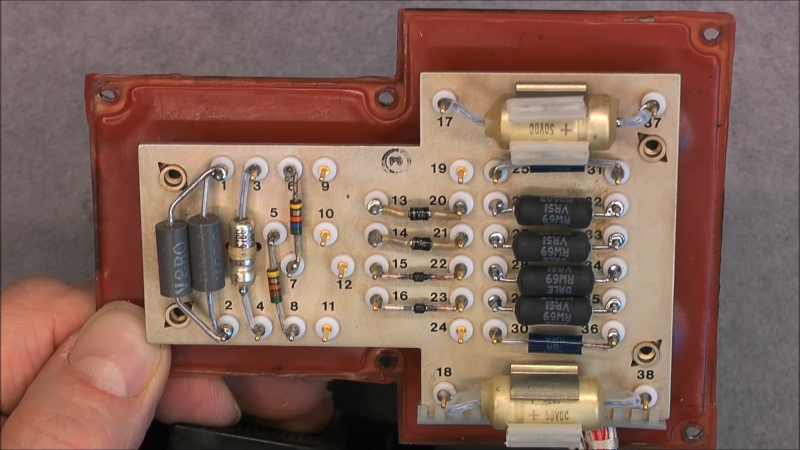It isn’t clear to us how [mrsylvain59] came into possession of a late-model piece of military gear from the German airforce, but we enjoyed watching the teardown below anyway. According to the documentation, the thing has a huge price tag, although we all know that the military usually pays top dollar for various reasons, so we are guessing the cost of the parts is quite a bit less than the price tag.
We don’t think [mrsylvain59] was sure what the amplifier (verstärker is German for amplifier) does. However, we recognized it as an avionics box from a UH-1 helicopter. We aren’t sure of its exact function, but it is classified under “Automatic Pilot Mechanisms and Airborne Gyro Components.”
The wiring harnesses, though, are thick and nicely done. The top board isn’t a traditional PCB, but a board full of solder contacts. There’s also a large transformer and some potted assemblies. Under a panel, there are also a couple of very beefy transistors with Solitron logos on them.
While we don’t know exactly what this amplifier does, we always enjoy peeking inside this equipment that we’d normally never get a chance to see. We aren’t sure what his plans are for the box or the components inside, but we doubt it is going back in a helicopter.
While we are no fan of warfare, we have to admit it makes for interesting hardware. We’ve looked at range computers and Soviet missiles, among other things.















BTW, Lowes sells Wiha screwdrives now. Just a few models only.
Make a guitar amp out of it
If I were to take a stab in the dark I’d say it’s an amp from the SCAS system
There was a story in 73 in the sixties where someone found some surplus, and it exploded. This was fiction, but apparently there were explosive charges in some equipment, so it couldn’t fall into enemy hands
Yes, it’s not very common but it did exist, for instance some soviet spy radio sets were equiped with such self destruct charges, they looked like brass cylinders.
Nah they just put a cap in backwards ;)
Is similar to a Sperry instruments type Vertical Gyro 2587335-12 or Directional Gyro are the components mounted on teflon standoff
Military electronics cost so much due to the operating requirements. It’s easy to make an amplifier that will work on your bench at normal ambient temps. It’s a hell of a lot more complicated to make that same amplifier work at temps between -50F and +150F with vibration requirements. Lets not forget the resistance to EMP that is also needed for this type of electronics. This shit was made to survive a Nuclear war!
Well, it’s not just the operating requirements, but it’s the necessity to test the requirements. If you go to the store and buy a screwdriver you just assume it’s going to be okay. But in traditional military procurement, there would be exact specifications about the strength of the blade and the tolerance of the blade and the exact size. The handle with specific tolerances and the strike force that the handle could take before it breaks… And all of that would have to be tested and documented. Oddly enough, you can’t do that for free lol. Part of the problem is military procurements tend to get big requirements that are sometimes difficult to meet. And that causes expense and or unhappiness. So if you decide your jeeps have to operate in the tropics or in Antarctica you may wind up with a very expensive Jeep that doesn’t perform optimally in any case. However, if you limit your Jeep to where it’s warm and get snow cats for where it’s cold, everyone’s generally happier and it’s cheaper because you can buy those things off the shelf (COTS). You are not wrong, the requirements drive cost but also sometimes it is unrealistic requirements and in every case the testing of the requirements is often the bulk of the cost compared to actually making the part.
It how you blast Fortunate Son while heading into conflict, duh.
The military pays (with civilian tax dollars) more than $160 for each 2n2222 transistor, wth!